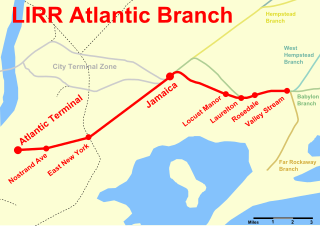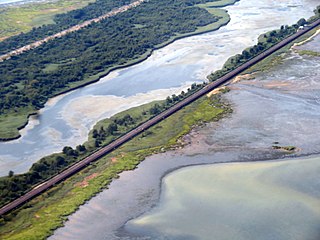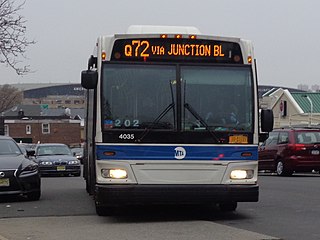Related Research Articles

The Atlantic Branch is an electrified rail line owned and operated by the Long Island Rail Road in the U.S. state of New York. It is the only LIRR line with revenue passenger service in the borough of Brooklyn.

The Far Rockaway Branch is an electrified rail line and service owned and operated by the Long Island Rail Road in the U.S. state of New York. The branch begins at Valley Interlocking, just east of Valley Stream station. From Valley Stream, the line heads south and southwest through southwestern Nassau County, ending at Far Rockaway in Queens, thus reentering New York City. LIRR maps and schedules indicate that the Far Rockaway Branch service continues west along the Atlantic Branch to Jamaica. This two-track branch provides all day service in both directions to Grand Central Madison and Penn Station, both in Midtown Manhattan
Woodhaven Boulevard and Cross Bay Boulevard are two parts of a major boulevard in the New York City borough of Queens. Woodhaven Boulevard runs roughly north–south in the central portion of Queens. South of Liberty Avenue, it is known as Cross Bay Boulevard, which is the main north–south road in Howard Beach. Cross Bay Boulevard is locally known as simply "Cross Bay", and Woodhaven Boulevard, "Woodhaven". The completion of the boulevard in 1923, together with the construction of the associated bridges over Jamaica Bay, created the first direct roadway connection to the burgeoning Atlantic Ocean beachfront communities of the Rockaway Peninsula from Brooklyn and most of Queens.
The Rockaway Beach Hotel, also known as the Hotel Imperial, was a very large hotel built in Rockaway, Queens, New York City during the late 1870s and early 1880s by the Rockaway Improvement Company. The hotel, promoted as the "biggest hotel in the world", ran along the Rockaway beachfront from the present-day Beach 110th Street to Beach 116th Street, thus locating it in the contemporary Rockaway Park neighborhood rather than Rockaway Beach as the name implies.
The North Shore Bus Company operated public buses in Queens, New York City. It was established in 1920 as the successor to the New York and North Shore Traction Company trolley system, and operated until 1947 when it went bankrupt, and its operations were taken over by the New York City Board of Transportation.

The Raunt was a former Long Island Rail Road station on the Rockaway Beach Branch. It had no address and no station house, because it was meant strictly as a dropping-off point for fishermen using a small island in Jamaica Bay. The station was located 1,300 feet (400 m) west of signal station "ER", and near the WU Tower. It was named for the channel on the south side of the island where it stood.

Glendale was a Long Island Rail Road station along the Lower Montauk Branch, located in Glendale, Queens at Edsall Avenue and 73rd Street, near Central Avenue, at the All Faiths Monuments factory for the All Faiths Cemetery. This station had two "platforms" which were just strips of pavement besides the tracks signed as the station, and two tracks.

Hamilton Beach was a former Long Island Rail Road station on the Rockaway Beach Branch in Queens, New York City. It was located between two streets in Hamilton Beach, Queens, one of which no longer exists and is part of land owned by JFK Airport.
The Ocean Electric Railway was a street car line that operated on The Rockaways. It ran parallel to parts of the Rockaway Beach Branch and Far Rockaway Branch of the Long Island Rail Road. The headquarters of the OER were at the Far Rockaway Long Island Rail Road station which was then located across Mott Avenue from the existing Far Rockaway–Mott Avenue subway station. The Office of Superintendent - Trolleys at that location managed all the LIRR's owned trolley operations.
Hammels was a Long Island Rail Road station on the Rockaway Beach Branch in Hammels, Queens. It was located at what is today Beach 84th Street at the west leg of the Hammels Wye.
Beach Channel was a Long Island Rail Road station on the Rockaway Beach Branch in Broad Channel, Queens, New York. It was located on the north end of the Beach Channel Drawbridge across from the north leg of the Hammels Wye.
The Manhattan and Queens Traction Company, also known as the Manahttan and Queens Transit Company, was a streetcar company operating in Manhattan and Queens County, New York between 1913 and 1937.
Queenswater was a train station along the Long Beach Branch of the Long Island Rail Road. It was located along Reynolds Channel and was used between 1898 and 1936 to serve numerous fishing clubs and hotels.

The Q111, Q113, and Q114 bus routes constitute a public transit line between the Jamaica and Far Rockaway neighborhoods of Queens, New York City, running primarily along Guy R. Brewer Boulevard. The Q113 and Q114 provide limited-stop service between Jamaica and Far Rockaway, connecting two major bus-subway hubs, and crossing into Nassau County. The Q111 provides local service exclusively within Queens, with the exception of select rush-hour trips to or from Cedarhurst in Nassau County. Some of the last bus routes to be privately operated in the city, they are currently operated by the MTA Bus Company brand of MTA Regional Bus Operations. The Q113 and Q114 are one of the few public transit options between the Rockaway peninsula and "mainland" New York City.

The Q72 bus route constitutes a public transit route along Junction Boulevard and 94th Street in Queens, New York City. It operates between the Rego Park and East Elmhurst neighborhoods of Queens, and extends into LaGuardia Airport at the north end of the borough. It is city-operated under the MTA Bus Company brand of MTA Regional Bus Operations.

The Q11, Q21, Q52, and Q53 bus routes constitute a public transit corridor running along Woodhaven and Cross Bay Boulevards in Queens, New York City. The corridor extends primarily along the length of the two boulevards through "mainland" Queens, a distance of 6 miles (9.7 km) between Elmhurst and the Jamaica Bay shore in Howard Beach. The Q52 and Q53 buses, which provide Select Bus Service along the corridor, continue south across Jamaica Bay to the Rockaway peninsula, one of the few public transit options between the peninsula and the rest of the city.

The Q65 bus route constitutes a public transit line in Queens, New York City. The south-to-north route runs primarily on 164th Street, operating between two major bus-subway hubs: Sutphin Boulevard–Archer Avenue station in Jamaica and Flushing–Main Street station in Flushing. It then extends north along College Point Boulevard to College Point at the north end of the borough. The route is city-operated under the MTA Bus Company brand of MTA Regional Bus Operations.
References
- ↑ Antos, Jason D. (2012-04-18). "Seyfried Belongs To The Ages". Queens Gazette. Retrieved 2012-04-23.